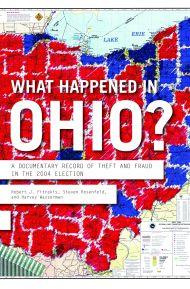See Audio track at bottom.
Bob Fitrakis
Missing votes in Ohio call races into question
January 2, 2007
While Democratic Party supporters celebrate their success in Ohio, where their statewide candidates won four out of five executive offices and they now control both the U.S. House and Senate, they are ignoring massive and verifiable irregularities in the 2006 election. Similar irregularities – including missing votes, undervotes and overvotes – may come back to haunt the Democrats in the 2008 general election.
The only statewide partisan loss for the Democrats was also the closest contest. Republican Mary Taylor defeated Democrat Barbara Sykes for State Auditor by an official vote of 50.64% to 49.36%. Taylor prevailed by 48,826 votes. The Columbus Dispatch’s final poll, usually the most accurate in the state for candidate races, predicted Sykes would win by 10%.
An analysis by the Free Press documents massive discrepancies between the unofficial turnout reported by Ohio Secretary of State J. Kenneth Blackwell immediately following the election and the official general election turnout numbers reported in December 2006. These discrepancies may help explain Sykes’ unexpected loss.
In Cuyahoga County which contains the Democratic stronghold of Cleveland, immediately following the election 562,498 votes were reported cast with 30,791 listed as absentee or provisional ballots. The official results show 468,056 counted in Cuyahoga. This means that 94,442 ballots cast in the unofficial total disappeared in the official tallies. This represents a shocking 16.8% of all the votes cast in Cuyahoga.
Sykes won 62% of the vote in Cuyahoga County.
Cuyahoga County uses the controversial Diebold touchscreen voting machines. These machines suffered a notorious meltdown in the 2006 primary where many machines malfunctioned and an Election Science Institute (ESI) report documented significant differences between votes actually cast on the machines as opposed to counted.
Similarly in Lucas County, another Democratic stronghold, 17,351 votes disappeared (10.6% of the total vote) between the unofficial and official turnout numbers. An analysis by Dr. Richard Hayes Phillips indicates that Taylor, a first-time statewide office seeker, ran significantly ahead of Republican incumbent candidates Mike Dewine and Betty Montgomery, in the Senate and Attorney General races respectively.
Other counties with significant and unexplained loss of votes include: Auglaize (15.7%), Coshocton (14.1%), Jackson (11.3%), Licking (14.1%), Morrow (17.4%), and Tuscarawas (11.7%). In these less populated counties, Democratic gubernatorial candidate Ted Strickland won in five out of six and Democratic U.S. Senate candidate Sherrod won in four out of the six.
Normally, the official total vote tally increases as provisional ballots are added to the unfficial total. For example, Franklin County had 342,958 votes unofficially with 46,458 provisionals and a few late overseas absentee ballots. The official Franklin County result was 385,863 votes cast, a pickup of 42,905 ballots once the provisionals were counted. Eleven of Ohio’s 88 counties reported this anomaly of fewer votes in the official total than the unofficial total.
Other election anomalies that bear further investigation are six counties with improbable undervote percentages in the U.S. Senate race. On average in Ohio, 3.9% of the ballots contained an “undervote,” meaning no vote was cast in the Senate race. But, in the Senate race there were significant undervote totals: Adams County had 14.1%; Darke County had 13.5%; Highland had 13.8%; Mercer had 11.2%; Montgomery had 13.8%; and Perry had 16.3%. The city of Dayton is in Montgomery County where more than 30,000 ballots recorded no vote for Senate. Brown won 53% of the vote in Montgomery County.
In comparison with the undervote in the well-known District 13 race in Sarasota, Florida, the undervote was 18,382.
In the Sykes race, the undervote for Auditor in Cuyahoga County was 10.7%. Undervotes were 8.3% of the total vote in Lucas County. Skyes’ undervote total in these Democratic havens should have been examined along with the bizarre unofficial vs. official vote totals in these counties.
The state auditor’s office in Ohio has enormous power to investigate and root out official corruption involving public funds. Many critics of Republican Party scandals in Ohio have pointed to the GOP’s control of the state auditor’s office as the key to delaying and minimizing public scrutiny.
Franklin County and the Squire challenge
Although the election numbers are stranger in Cuyahoga and Lucas counties for the Democrats, an election contest complaint filed in the Franklin County Court of Appeals by Judge Carol Squire documents in great detail the problem with electronic voting machines based on the results of her 2006 race. Incumbent Squire filed the action on December 22 after losing by 13,064 votes to Chris Geer for a seat on the County Court of Common Pleas.
The action seeks to “declare invalid and set aside” Squire’s loss. The complaint requests a full evidentiary hearing.
Squire hired Dr. Rebecca Mercuri, President and Chief Technical Officer of Notable Software, Inc. as an expert witness and investigator. The former Bryn Mawr computer science professor holds a Ph.D. in computer and informational science from the School of Engineering and Applied Science at the University of Pennsylvania. Mercuri’s sworn affidavit contains detailed criticisms of the Franklin County Board of Elections (BOE) and its conduct of the 2006 election. Her sworn statements include the following:
- 35 precincts were unable to close “due to problems with printers, machine malfunctions, infrared readers, PEBs [personal electronic ballots] . . . .” Squire paid for a recount of these 35 precincts but the BOE used the real time audit log (RTAL) paper tapes to recount only 2 of the 35 precincts. The RTALs are the only way to accurately assess how people really voted on the Election Day.
- In the BOE warehouse “hundreds of RTAL paper rolls were sitting out on various tables . . . It had been my understanding that sealed containers holding the rolls would be open only in the presence of observers, but this apparently had already been done, and the rolls extracted, prior to the observers’ arrival.”
- “Many of the rolls” lacked “tamper-proof” tape, which seals the RTALs at the end of Election Day in case of a recount. Instead, they had stickers which could be easily tampered with.
- “Some of the [RTAL] rolls did not have a sticker” leaving them open for tampering or accidental destruction.
- “. . . Others [RTALs] had a sticker with handwritten initials on it” indicating that the roll “was replaced by a service person during the Election Day.” This raises questions concerning chain of custody of the rolls, the functionality of the machines, and identity and background of the technicians who initialed the stickers.
- “. . . A considerable number of the rolls were incomplete, possibly because the paper roll had run out or been changed, although for some, it was evident that the end of the paper roll had been damaged or ripped.”
- “. . . between five and ten percent of the machines had either not printed an end tally,” or “it was missing.”
- In one case, when Mercuri requested the information at the beginning of the RTAL roll be read aloud during the recount, the phrases “password override” and “PEB failure” were read from the audit log. Mercuri concludes that “. . . this might have indicated a pre-election breach of security or protocol for that equipment.”
- “It was observed that some of the equipment problem report pages had been previously removed from the pollbooks.”
- “The warehouse facility appeared to be shared by other agencies, as there was a large SWAT team truck behind some of the rows of voting machines . . . .”
Mercuri’s 16-page affidavit concludes that Squire was denied “an appropriate recount” from a voter-verified paper trail using the RTAL rolls and also points out that the “voting system was inappropriately configured and improperly used during the election.” The Franklin County BOE used different versions of hardware that were not certified prior to the election.
“The use of mismatched components violates certification requirements and also runs the risk of exposure to programming errors (bugs) or security vulnerabilities that could compromise the integrity of the election and result in the loss or mistabulation of votes,” Mercuri states.
In late November the National Institute of Standards and Technology (NIST), one of the federal government’s premier research centers, condemned electronic voting machines noting that as presently configured, they “cannot be made secure.”
In an audit of 25% of Franklin County’s precinct pollbooks and signature books, Squire’s elections investigator Rady Ananda found massive problems with over reporting of votes. Only 29 out of 216 precincts matched the number of signatures to the number of votes cast. Eight precincts reported more than 100 more votes cast than signatures in the pollbooks.
A similar problem of fewer votes being recorded than voter signatures also occurred with one precinct having 100 fewer votes on the machine than signatures. In all, 136 precincts fell into this category. Columbus Ward 66 Precinct G was missing 123 votes. An audit of Miami County by a Free Press investigation team following the 2004 presidential election found a similar problem of optiscan precinct totals not matching signature books. In the spring 2006 primary election, the ESI audit of Cuyahoga County found similar problems.
Cuyahoga’s problems reappeared in the 2006 general election. The Cleveland Plain Dealer reported that, “Nearly 12,000 people in Cuyahoga County cast votes illegally on Election Day without signing the election books, or likely, showing identification as required by a new state law.”
“An analysis showed that 533 of the 570 Cuyhoga County voting precincts reported more votes than voters signed in.” The Plain Dealer found that: “With some polling places, the numbers were off by more than 100.”
Beverly Campbell, a 2006 Democratic candidate for the Ohio Statehouse, lost by 368 votes in Franklin County. She told the Columbus Dispatch that “her campaign has questions similar to Squire’s about vote and signature totals.” In a meeting with the Free Press, she supplied a worksheet from her own investigation of 98 precincts where there were problems in 88 of them either with more votes cast than signatures or more signatures than votes cast. In all, she found 483 more votes than signatures and 300 missing votes.
Squire’s complaint also asserts that “over 2500 provisional ballots were discarded with no opportunity for observers to obtain the basis or justification for rejection.”
The voting irregularities in the 2006 election appear to be greater than in 2004, but many Ohio Democrats have chosen to ignore that reality. But one who hasn’t taken that position is newly-elected Secretary of State Jennifer Brunner, who has pledged a complete review of the electronic voting machines. The facts remain that not every vote is counted or accounted for in the Buckeye State and this could be the key factor in deciding the next president of the United States.
—
Bob Fitrakis is the co-author of What Happened in Ohio: A documentary record of theft and fraud in the 2004 election published by the New Press.
Find the Original Article @ https://freepress.org/columns/display/3/2007/1481



 Hello!
Hello!
 I haven’t blogged since the election, although there have been a few postings of articles I’ve written for the Free Press. But I break this unofficial vow of silence to mourn Molly Ivins, the longtime Free Press columnist and Pulitzer Prize-nominated writer.
I haven’t blogged since the election, although there have been a few postings of articles I’ve written for the Free Press. But I break this unofficial vow of silence to mourn Molly Ivins, the longtime Free Press columnist and Pulitzer Prize-nominated writer.
